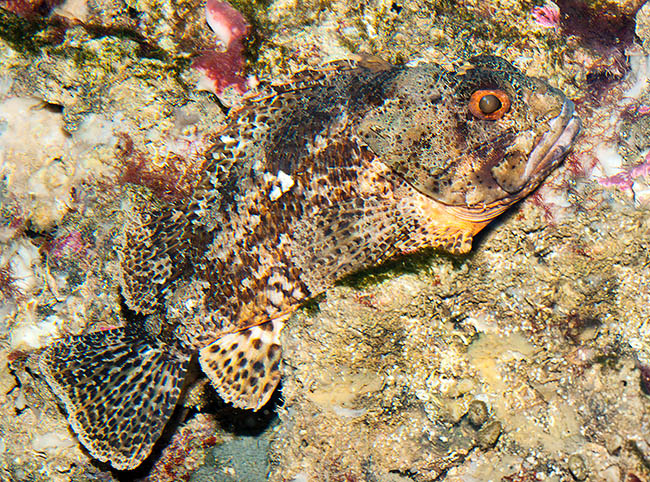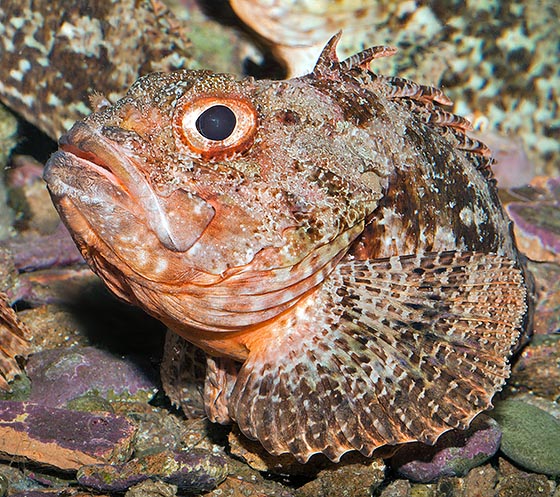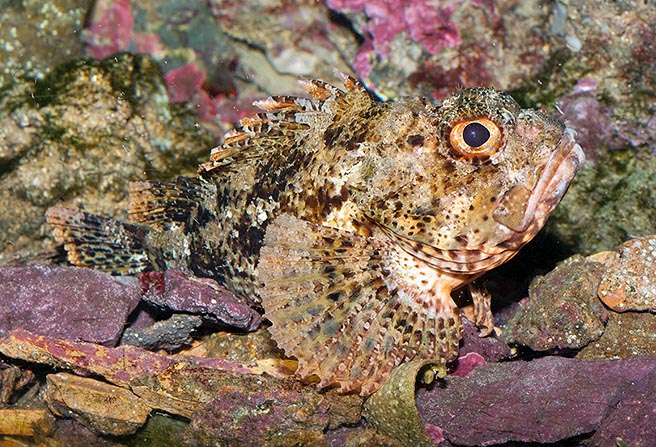Family : Scorpaenidae

Text © Giuseppe Mazza

English translation by Mario Beltramini

Small red scorpionfish (Scorpaena notata) is characterized by mimetic dots also on the fins © Giuseppe Mazza
The very mimetic Small red scorpionfish (Scorpaena notata Rafinesque, 1810) belongs to the class of Actinopterygii, the ray-finned fishes, to the order of Scorpaeniformes and to the family of Scorpaenidae.
The name of the genus is the one given by the old Romans to these fishes, with reference to the spines, which evoke the stings of the scorpions.
The name of the species comes from the Latin “notatus” = marked, labelled, with reference to the mimetic dots present on the fins.
Zoogeography
The small red scorpionfish is present all over the Mediterranean, but the Black Sea. After Gibraltar Strait, it goes north- wards, along the Atlantic coasts, up to the Biscay Gulf, and, southwards, it colonizes the African ones up to Senegal, including the Azores, Madeira, Canary and Cape Verde islands.
Ecology-Habitat
It is a benthic species which may reach the 700 m of depth, even if, usually, it lives around the 200 m and it has been found at about 10 m.

Colour is very variable, mostly dark brown and pink orange © Giuseppe Mazza
Like all scorpionfshes, it’s a fish loving to live isolated, possibly sheltered by a rock, where it feels perfectly safe seen its exceptional mimetic capacities.
Morpho-physiology
Scorpaena notata can reach the 24 cm, but rarely exceeds the 18 cm and the most fished specimens measure 12-15 cm. Due to the size and the stocky body, even if proportionally taller, it reminds the Black scorpionfish (Scorpaena porcus), another master of camouflaging, whilst the colour is closer to that of the Red scorpionfish (Scorpaena scrofa).
The laciniae are scarce because the mimetic effect is based mainly on the maculated pattern interesting the body as well as the fins. Given that usually the juveniles are darker, we go from the dark-brown to the pink-orange, to the violaceous and even, seen from above, to the greenish.
The specific characteristic, as briefly stated in the etymology, stands in the dark spots on the fins, in particular the caudal, the anal and the dorsal, which usually shows a big patch in the last spiny rays.
The head is short, armoured by countless spines, with big eyes for seeing well also in the darkness and an ample mouth, slightly longer, carrying 4-5 bands of villiform teeth. The jaw has one more band and also vomer and palatines have similar teeth. The unique dorsal fin, shows 12 spiny rays connected to poison glands and 9-10 soft rays; the anal counts 3 spiny rays and 5 soft; the ventral ones one spiny and 5 unarmed.

Clever who can see it in its habitat! The dorsal spiny rays are poisonous © Giuseppe Mazza
The pectoral fins are ample and elongated, up to almost the height of the first ray of the anal. The caudal fin is rounded.
Ethology-Reproductive Biology
Scorpaena notata is a greedy carnivore who goes hunting during the night. Small fishes, crustaceans and other invertebrates belong regularly to its diet.
It reproduces during the summer with floating eggs, merged, ad usual, in gelatinous small masses. Even if, like the other scorpionfishes, it is an ingredient of the fish soup, it is fished only occasionally, and it is not surely an endangered species, also because its population may double in 1,4-4,4 years. The fishing vulnerability index scores 34 on a scale of 100 and has been included in the Red List of endangered species as “Least Concern” since 2014.
Synonyms
Scorpaena ustulata Lowe, 1841; Scorpaena teneriffea Jordan & Gunn, 1898; Scorpaena scrofa afimbria Slastenenko, 1935; Scorpaena afimbria Slastenenko, 1935.
→ For general information about FISH please click here.
→ For general information about BONY FISH please click here
→ For general information about CARTILAGINOUS FISH please click here.
→ To appreciate the BIODIVERSITY of BONY FISH please click here.
→ To appreciate the BIODIVERSITY of CARTILAGINOUS FISH please click here.
